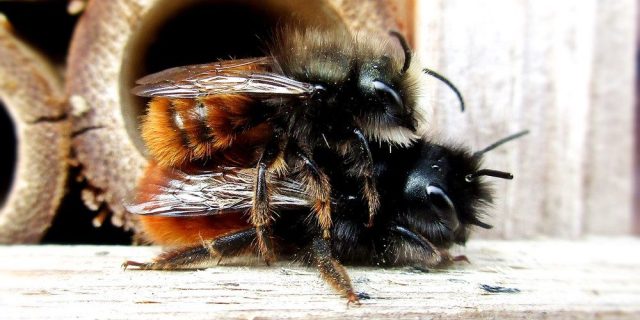03
May
Fungicide Found to Jeopardize Male Pollinator’s Ability to Find a Mate, as EPA Ignores Risk

(Beyond Pesticides, May 3, 2022) Exposure to a commonly used fungicide considered to be ‘slightly toxic or nontoxic’ to pollinators makes male mason bees less likely to find a mate, jeopardizing future generations of critically important pollinators. This determination comes from research recently published in the Journal of Applied Ecology by scientists at Germany’s University of Würzburg. The timing of these findings comes after the U.S. Environmental Protection Agency (EPA) reapproved uses of fenbuconazole, the fungicide in question, late last year without completing all required studies on pollinator health effects.
Horned mason bees (Osmia cornuta), a solitary bee species, have a complex mating process that includes a range of “pre-copulatory behaviors” used by male bees attract females. Males create thoracic vibrations with their flight muscles, rub the eyes of female bees with their antennae, and emit a distinct odor from their body. If the female likes the presentation, she will mate with the male. Otherwise, she will move him to the side and wait for another male to try to win her affection.
To see how this process was influenced by pesticide exposure, researchers conducted a range of different experiments. For the first, newly emerged male and female bees were tagged in a laboratory setting, and male bees were exposed to either none, 50%, or 100% of field application rate for the fungicide product Indar 5EW, containing a solution of fenbuconazole in order to mimic bees caught in a spray event. Five male bees from each group were placed in a flight cage with a single female and their activity was observed. Researchers used a total of 68 males, many of which were used more than once to mimic field conditions where males mate with multiple females. A second experiment tested mating pairs by allowing a virgin female to interact with either five males in the control group of five males exposed to 100% field rate of the fungicide. Once a mating pair was established they were removed and observed separately. Scientists likewise analyzed the thoracic vibrations initiated during precopulation, and as well as the cuticular hydrocarbons (odors) of the bees within the first experiment.
“If the fungicide has an effect on male quality signals, this should increase the likelihood that pesticide-exposed males will be rejected by females,” lead author of the study, Samuel Boff, PhD, explains. As indicated, the pesticide did appear to affect the ability of exposed males to mate. Results from the first experiment found exposed males to have significantly fewer successful copulations than the unexposed control bees. Unexposed bees mated 16 times, while 50% exposed mated five times and 100% exposed mated six. The fungicide did not stop the male bee’s attempt to mate, merely their success after initiating their mating dance. For the second experiment regarding mating pairs, control males were again 20% more likely to mate than the fungicide-exposed group.
While no difference was seen between the length of time control and exposed males conducted thoratic vibrations, the frequency of the vibrations was higher in the control group. Control and exposed bees also exhibited marked differences in the odors they emitted, likely influencing their overall success.
Resources like University of Massachusetts Extension and University of California rate the active ingredient fenbuconazole as slightly toxic or nontoxic to pollinators not requiring any bee precautions unless indicated on the label. But the team of European researchers are calling for deeper investigations before such broad labels are messaged to the public. “Our study shows that the early stages of bee reproduction must be included in the risk assessment of pesticides,” says Professor Thomas Schmitt, PhD, chair of animal ecology and tropical biologist at University of Würzburg.
While EPA updated its guidelines for pollinator risk assessments in 2014, the agency continues to either fail to conduct full assessments, or dismiss concerning data it receives. In its recent Interim Decision published on fenbuconazole, the agency notes that “For larval bees, RQs (risk quotients) exceed the LOC (level of concern) for all pollinator attractive uses including when assessed at the lowest application rate of 0.0938 lb a.i./Acre (RQ = 1.1).” Yet in the same document, the agency declares that “…the benefits of fenbuconazole (e.g., efficacy in management of fungal pathogens) outweigh any remaining risk and that continuing to register fenbuconazole provides significant benefits, including its ability to increase crop yields and help with resistance management.” While the agency added additional restrictive language on spray drift, it implemented no new precautionary measures for pollinators. With the only indications that this chemical is dangerous to pollinators deep in EPA’s dense review documents the public rarely if ever reads, the agency continues to fail pollinators, farmers, and the public.
As Dr. Boff notes, “The decline in bee populations in agricultural landscapes could therefore be explained by the effect of pesticides on insect mating behavior.” Yet, regulators at EPA have made clear that the benefits associated with killing wild pollinators outweigh the risk of crop loss.
Help create a future where pollinators do not dwindle but thrive by supporting the Saving America’s Pollinators Act. This bill would create a separate process outside of EPA’s industry-driven reviews with an independent board of experts to determine whether additional restrictions are necessary for pesticides with evidence of toxicity to pollinators or their habitat. Take action today by urging your member of Congress to join as a cosponsor.
All unattributed positions and opinions in this piece are those of Beyond Pesticides.
Source: Journal of Applied Ecology, ScienceDaily, EPA Registration Review-Fenbuconazole










